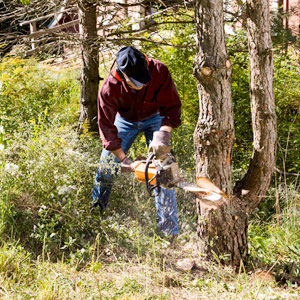Safe Chainsaw Usage
Follow safe operating procedures to minimize potential hazards from chainsaw usage. A chainsaw is inherently dangerous, but steps can be taken to minimize accidents and injuries.

- Wear protective equipment. This includes eye protection, hearing protection, steel-toed boots with heavy tread, a hard hat or other head gear with a full coverage visor, leg protection, and strong gloves with enhanced grip. Do not wear loose clothing.
- Read the manufacturer's instruction manual thoroughly. Take time to get acquainted with the saw. Practice first on smaller trees to get the feel for the saw. Instinctively learn where the shut off switch is located without having to look for it.
- Look at where the tree will fall. Trees tend to fall straight back and you need an exit plan. As you move away at an angle, make sure the area is free of debris and other tripping hazards.
- Verify that there are no nails, wire, or other metal in the tree before starting.
- Take time to assess the area and the tree. Is the tree leaning, what direction is the wind blowing, are there any power lines or buildings nearby?
- Be aware of where other people and pets/animals are at all times. Do not work too close to each other.
- Pay attention to the tension on trees and limbs that you are cutting and be careful to avoid them snapping back into you.
- Keep the chain in good working order: clean, sharpened, lubricated. Make sure the lubrication reservoir is full.
- Do not cut from a ladder, tree limb, or other elevated position.
- Cut at full throttle.
- Maintain proper tension on the chain according to manufacturer's instructions. A loose chain can come off and strike the operator.
- Do not refuel a hot chainsaw. Operate the saw at least 10 feet away from refueling area. Do not smoke while refueling. Be extra cautious during dry weather. Restart the chainsaw away from the refueling station.
- Always maintain secure footing when operating the saw. Do not hold the saw above waist level.
- Always turn the power off when carrying the chainsaw to the next tree.
- Learn about notching the tree and making corner cuts and back cuts.
- Never cut with the saw's tip. The tip should not be touching wood. Kickback could occur.
- Check with the landowners as to which trees may be cut and whether there is a stump height requirement. Check local ordinances for felling trees.
- Always carry a First Aid Kit with you and a cell phone.
